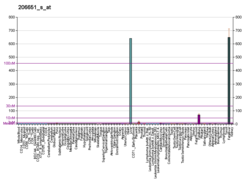Carboxypeptidase B2
Carboxypeptidase B2 (CPB2), also known as carboxypeptidase U (CPU), plasma carboxypeptidase B (pCPB) or thrombin-activatable fibrinolysis inhibitor (TAFI), is an enzyme that, in humans, is encoded by the gene CPB2.[5][6]
Function
CPB2 is synthesized by the liver[7] and circulates in the plasma as a plasminogen-bound zymogen. When it is activated by proteolysis at residue Arg92 by the thrombin/thrombomodulin complex, CPB2 exhibits carboxypeptidase activity. Activated CPB2 reduces fibrinolysis by removing the fibrin C-terminal residues that are important for the binding and activation of plasminogen.[8][9]
Carboxypeptidases are enzymes that hydrolyze C-terminal peptide bonds. The carboxypeptidase family includes metallo-, serine, and cysteine carboxypeptidases. According to their substrate specificity, these enzymes are referred to as carboxypeptidase A (cleaving aliphatic residues) or carboxypeptidase B (cleaving basic amino residues). The protein encoded by this gene is activated by thrombin and acts on carboxypeptidase B substrates. After thrombin activation, the mature protein downregulates fibrinolysis.[10]
 |
Isozymes
Polymorphisms have been described for this gene and its promoter region. Available sequence data analyses indicate splice variants that encode different isoforms.[10]
See also
References
- ^ a b c GRCh38: Ensembl release 89: ENSG00000080618 – Ensembl, May 2017
- ^ a b c GRCm38: Ensembl release 89: ENSMUSG00000021999 – Ensembl, May 2017
- ^ "Human PubMed Reference:". National Center for Biotechnology Information, U.S. National Library of Medicine.
- ^ "Mouse PubMed Reference:". National Center for Biotechnology Information, U.S. National Library of Medicine.
- ^ Eaton DL, Malloy BE, Tsai SP, Henzel W, Drayna D (Dec 1991). "Isolation, molecular cloning, and partial characterization of a novel carboxypeptidase B from human plasma". J Biol Chem. 266 (32): 21833–8. PMID 1939207.
- ^ Tsai SP, Drayna D (Dec 1992). "The gene encoding human plasma carboxypeptidase B (CPB2) resides on chromosome 13". Genomics. 14 (2): 549–50. doi:10.1016/S0888-7543(05)80268-X. PMID 1427879.
- ^ Kaushansky K, Lichtman M, Beutler E, Kipps T, Prchal J, Seligsohn U. (2010; edition 8: pages 1833-1834 and 2040-2041) Williams Hematology. McGraw-Hill. ISBN 978-0071621519
- ^ Zhao L, Morser J, Bajzar L, Nesheim M, Nagashima M (December 1998). "Identification and characterization of two thrombin-activatable fibrinolysis inhibitor isoforms". Thromb. Haemost. 80 (6): 949–55. PMID 9869166.
- ^ Boffa MB, Reid TS, Joo E, Nesheim ME, Koschinsky ML (May 1999). "Characterization of the gene encoding human TAFI (thrombin-activable fibrinolysis inhibitor; plasma procarboxypeptidase B)". Biochemistry. 38 (20): 6547–58. doi:10.1021/bi990229v. PMID 10350473.
- ^ a b "Entrez Gene: CPB2 carboxypeptidase B2 (plasma)".
Further reading
This article incorporates text from the United States National Library of Medicine, which is in the public domain.






